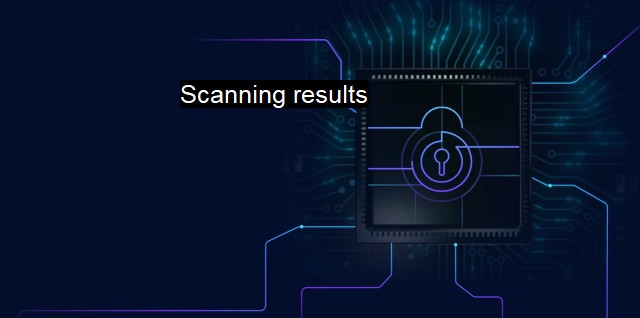What are Scanning results?
Understanding Scanning Results: The Key to Cybersecurity and Antivirus Success
"Scanning results," in the context of cybersecurity and antivirus activities, signifies the findings yielded as a result of performing a comprehensive analysis over a variety of documents, files, systems, and networks to identify potential threats or hazards that can hurt the integrity of data and systems. The term is extensively utilized in the discipline of Information Technology, particularly in fields related to network surveillance, malware assessment, and overall computer security.The foundation for "scanning results" lies in the process of computer scanning, a procedural method of analysis where an antivirus or cybersecurity software meticulously combs through every file, system, or network of a gadget to locate any potential threats, such as viruses, worms, Trojans, spyware, ransomware, etc. This scan could be performed manually by the user or be automated depending on the configurations of the antivirus software.
One of the first considerations for scanning results is their comprehensiveness. Comprehensive scanning results aid in organizing cybersecurity targets and priorities. They scrutinize every accessible file and software application into which malware could potentially broadcast, reducing the likelihood of a security breach. The system is scanned entirely, including emails, web files, system files, and individual files, leading to comprehensive and compelling results.
Scanning results, while clearly informing if a threat has been identified, also provide details about the nature and severity of the threats detected. They differentiate between mild threats, which may be merely frustrating advertising software, and severe threats, which can erase data or provide unauthorized access to personal information. These results can categorize the findings, making them more accessible and understandable to the user, aiding in making informed choices about problem-solving strategies.
So, how are these results achieved? An antivirus engine with effective scanning technology is the secret behind these cumulative and illustration results. The software cleverly stratifies the scanning process into phases, such as the analysis of binary codes and sequences, heuristic file inspection employing AI technology, and the incorporation of behavioral analysis. This complementary set of analysis leads to robust and informative scanning results.
When a scan completes, it populates a report known as "scanning results". These results detail which devices or files were scanned, what threats were located, how dangerous these threats might be, and the action taken by the software, such as whether the threat was quarantined or eliminated. This instructions can then be followed upon manually by the user, guiding the next course of action.
Responses to identified threats differ depending on the settings before the antivirus scan. Some security programs are set to either automatically quarantine or delete the threats. Meanwhile, others let the users decide what to do after the threats have been identified. The decisions largely depend on the severity, type, and location of threats identified in the scanning results.
Over time, Zeus, Koobface, Conficker, and Stuxnet are among high-profile malware that have siphoned billions of dollars globally and subjected countless individuals to undue stress. No tool is perfect. a well-configured antivirus software continually updated and run will provide thorough scanning results frequently enough to keep most internet-savvy users safe most of the time.
"scanning results" play a crucial role in maintaining cybersecurity, serving both as a status indicator for the existing security level and as a guide for future actions. Whether it's about identifying an already encroaching threat or finding potential loopholes that can materialize into a significant peril, scanning results initiatives strive to result in a stringent and reliable cyber environment.

Scanning results FAQs
What are scanning results in the context of cybersecurity and antivirus?
Scanning results refer to the final output generated by an antivirus software after scanning the computer system. These results indicate the presence or absence of any malicious software, virus or any other potential threat detected during the scan.How do I interpret scanning results generated by my antivirus software?
Interpreting scanning results is crucial to understand the current status of your computer system. The scanning results are usually categorized as Clean, Infected, or Suspicious. If the scanning results show clean, it means no malicious software is detected. If it shows infected, it means the antivirus software has detected one or more malicious software. If it shows suspicious, it means that the antivirus software has found some potentially harmful files, which need further investigation.What should I do if the scanning results show infected files?
If the scanning results show infected files, you should take immediate action to remove the virus from your computer system. The antivirus software usually provides the option to quarantine or delete infected files. You should choose the appropriate option to remove the virus from your computer system.Can scanning results be inaccurate?
Antivirus software uses complex algorithms and methodologies to scan computer systems for malicious software. However, it is possible that scanning results may not always be accurate. It can happen due to various factors like outdated antivirus software, incomplete scanning, or a new type of malware that is not yet recognized by the antivirus software. Hence, it is always recommended to keep your antivirus software up-to-date and perform regular scans to ensure maximum protection.| | A | | | B | | | C | | | D | | | E | | | F | | | G | | | H | | | I | | | J | | | K | | | L | | | M | |
| | N | | | O | | | P | | | Q | | | R | | | S | | | T | | | U | | | V | | | W | | | X | | | Y | | | Z | |
| | 1 | | | 2 | | | 3 | | | 4 | | | 7 | | | 8 | | |||||||